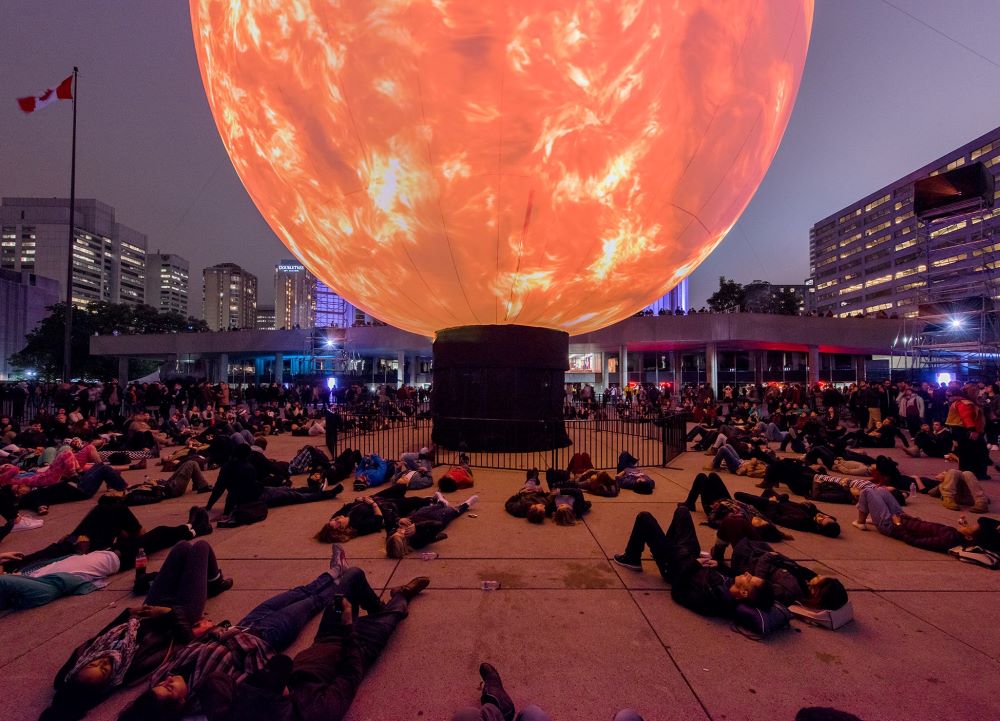Nineteen years ago this September, the inaugural Nuit Blanche brought artistry, spectacle, and even something of the provocative to Toronto, reinvigorating a local arts scene which had grown a bit complacent.
An all-night art party for the ages, Nuit Blanche 2006 featured a wealth of site-specific temporary works spread across the city, created by a range of artists both local and international. Highlights of that first Nuit Blanche included an eerie public park (dry ice machines working overtime at Philosopher’s Walk), a public pool reimagined as a home for the world’s most beloved queer penguins, and a twelve-hour antifascist protest by a very angry (and correct) Hungarian performance artist.
For years, Nuit Blanche Toronto continued to deliver on the promise of that first night. Projects got bigger – who can forget 2016’s massive glowing sun in Nathan Phillips Square (that piece, incidentally, the brainchild of prolific Canadian music video director, Director X) – but they also got smarter, stranger, more political.
In 2012, Gen X legend Douglas Coupland’s Museum of the Rapture imagined a post-apocalyptic hellscape in the underground parking garage at City Hall. In 2018, Jennifer Baichwal and Nicholas de Pencier (longtime collaborators of photographer Edward Burtynsky) took over the AGO atrium for a video installation which placed viewers at the heart of an old growth forest, moments before destruction. One year, I saw two well-dressed ladies devour an entire Victorian-style banquet in one sitting.
But something funny/sad happened along the way: even as Nuit Blanche continued to deliver at least a handful of noteworthy installations each year, the rest of the event began to crumble.

Big name artists like Coupland or Michael Snow simply stopped showing up. Increasingly, the most popular works were – deliberately? – situated in the smallest of venues, ensuring nightlong queues to capture that one perfect Insta-friendly shot, at the expense of, y’know, actually taking the time to explore a city’s worth of art.
And that worst of art world evils, “corporate synergy” (shudder), began to displace actual art and artists in favour of grotesque “brand activations” (double shudder) for the likes of Netflix, an alcoholic beverage company, and a car manufacturer.
Perhaps the most worrying sign of Nuit Blanche’s collapse was the growing presence of officially designated dance parties, organizers evidently giving in to the event’s reputation as a haven for drunk undergrads. Why offer up rebellious, experimental performance art when you can just hang a disco ball and hire a DJ?
Still, and against all odds, Nuit Blanche managed to stay at least half-interesting. While most true art lovers (understandably) avoided the SponCon alcohol-fuelled nightmare it had become, organizers, probably inadvertently, continued to book one or two interesting artists, one or two art pieces with something to say. As late as last year, your resident Guardian art critic was still out here defending Nuit Blanche, with its riveting experimental dance pieces and the quietly amusing sight of two roadwork signs caught up in an argument.
I’m not sure I can say the same any longer.
2025’s Nuit Blanche represented, with very minor exceptions, everything this event has long been accused of, but which I (and others) have for years staunchly defended it against. Nuit Blanche was bland and corporate. It was unoriginal. It was plagued by ear-splittingly loud dance parties. It wasn’t even particularly Instagram-friendly.
It also made several weird choices which almost read like self-sabotage. No big installation dominating Nathan Phillips Square. No Scarborough “hub”. An overreliance on video projections in place of the physical, tactile works which defined its early years. Too many projects indoors, instead of out in the great wide open. (And this on an unseasonably warm night, no less.) Bizarrely, several of Toronto’s most important arts institutions – TIFF Lightbox, Art Gallery of Ontario, OCAD(!) – kept their doors shuttered for the night.
Installations were scattered incoherently across the city, making it easy to get lost as you wandered, trying to figure out where the next piece was hiding. Hell, Nuit Blanche even failed to deliver on its already embarrassingly limited street closure: despite assurances of a pedestrian-only Dundas along University and Spadina, at least some north/south intersections remained open for cars.
It would be easy to blame, as many have, the loss of original corporate sponsor Scotiabank, which cut ties with Nuit Blanche in 2015. But that would be oversimplification. The event by then had already begun to sour, and anyway Nuit Blanche continued to pull off exceptional, big ticket installations in the years to come, proving that a big fat title sponsor wasn’t strictly necessary so long as you had curators – and artists – with a vision.
Yes, money matters, but so does political will, and it’s not hard to track the decline of Nuit Blanche against the rise of conservative, small-minded politics which started to dominate this city and province in the mid-2010s. Under Mayor John Tory, Toronto’s art budget was slashed year over year between 2014 to 2023. In roughly the same period, our province also welcomed the arrival of faux “working class guy” Doug Ford, whose cuts to the arts – alongside everything else – have been even more ruthless, the Ontario Arts Council taking a particular hit.
When the institutions responsible for supporting art and artists are themselves diced to ribbons, it’s no surprise when the art becomes smaller, boring, more provincial.
Is there an answer to all of this? A reason to hope for Nuit Blanche’s future? Will there even be Nuit Blanches future?
On the positive side, the expansion of Nuit Blanche into effectively three concurrent events – one for the city proper, one for North York, and one in Scarborough* – has proved a wise one, bringing art to the suburban masses who might not otherwise be so exposed. (*Though one wonders what organizers could possibly have been thinking by cancelling the popular Nuit Blanche Scarborough this year.)
Under progressive mayor Olivia Chow, arts budgets are also starting to be restored, though they’re still not back to previous levels, and Chow has been busy contending with across-the-board provincial cuts to everything from social services to healthcare to education. If Mayor Chow can win next year’s election – incidentally scheduled to take place a couple weeks after Nuit Blanche 2026 – it’s probably safe to assume a resurgence in arts funding will follow.
And yes, there’s probably room in there for some corporate partnerships, though it’s essential that, for the integrity of the event (and to win back audiences), all those poorly masked advertisements get excluded. If that means a return to the old model – corporate hegemons competing to artwash their sullied image through sponsorship of individual artists doing interesting things – so be it.
This year, however, was a dud.
I can speak only to the downtown portion – after exhausting the meagre offerings, I had neither the time nor the inclination to check out the weirdly random assortment of other hubs, which included “Danforth East” and Etobicoke – but there was little on display to justify the twelve hours I’ve happily given over in years past.
Surrounded by drunken idiots, oppressed by yet more brand activations – one of the official exhibits this year was a goddamn energy drink ad, for crying out loud – I finally gave up. And I know I’m not the only one.
***
The City of Toronto’s wonderful Archives team maintains a database of Nuit Blanche exhibits dating back to its inception. The nostalgic, or those who dare dream of a better future, are highly encouraged to check it out.



